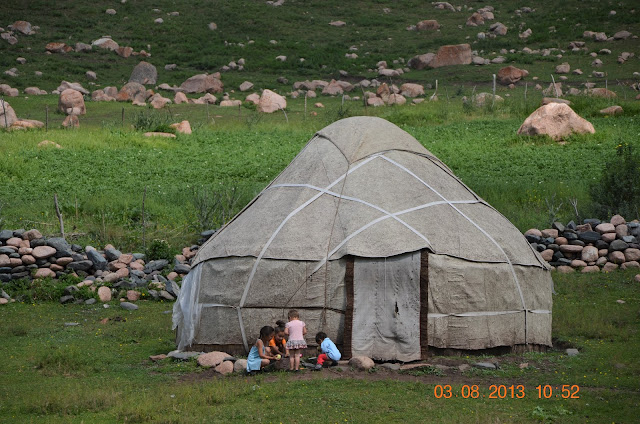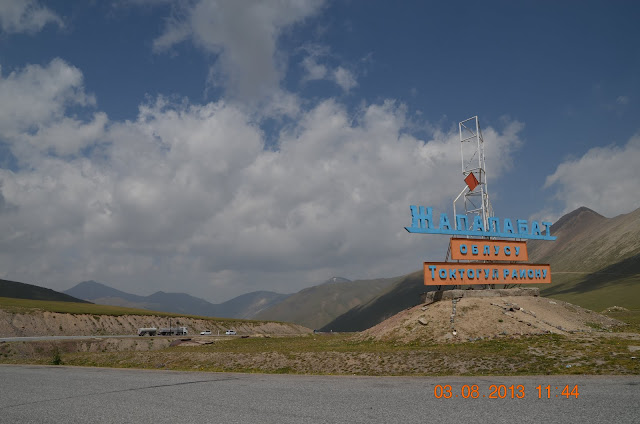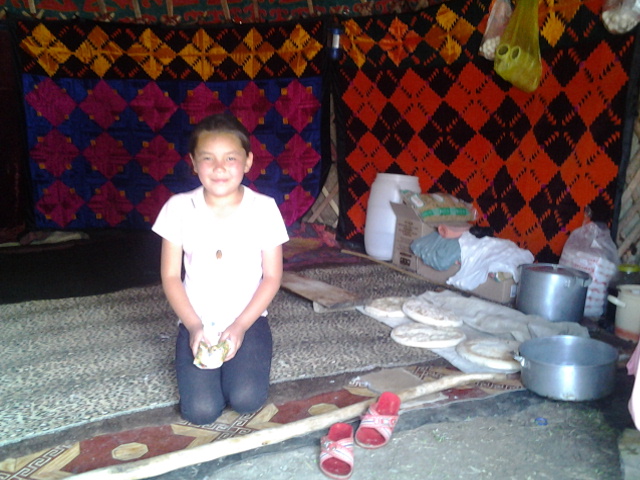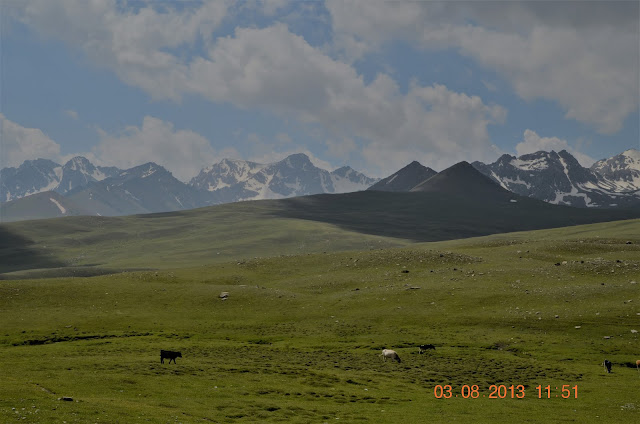We left Toktogul in the morning and continued north on M41, driving through the picturesque Chychkan valley. Here, the M41 travels alongside the river Chychkan. We started at an elevation of about 1,500m and climbed all the way to more than 2,500m. At the end of Chychkan Valley, we ascended into Ala-Bel pass, the highest point of the pass stands at an elevation of 3,175m.
On this stretch of road about 40km north of Toktogul city, there are a lot of beekeepers.
Honey in clear bottles are put out for sale along the roadside.
A most likely spot for a picnic or camping...note the yurts ..
After a while, we spotted a group of local beekeepers busy collecting honey a little further up the hill slope not too far from the roadside. We decided to have a look around.
Burning wood to create smoke.
Smoke is used to pacify the bees as the beekeepers collect honey.
Beekeeper holding up one of the frames. Not all the honeycombs are sealed on this frame. Only the sealed ones have honey in them.
The bees store the honey in honeycombs to be eaten later during winter time or whenever food is in short supply. The hardworking honey bees often produces more than they need allowing the beekeepers to collect the excess honey.
The frames full of honey are then arranged inside this barrel. The beekeeper spins the frames and the centrifugal force extracts the honey from the comb and collects it at the bottom of the barrel.
The honey is then collected in large containers and later put through a sieve to separate the debris from the clear gold liquid before it is packed in clear bottles for sale.
Me holding a piece of honey comb and the friendly local beekeepers. Before we left, we bought a bottle of honey and thank the beekeepers for sharing a part of their day with us.
Another family of beekeepers along the M41.
The M41 cuts through mesmerizing mountain ranges and rolling green valleys. These mountain ranges are part of the Tien Shan Mountain range that stretches from Uzbekistan to China.
A stream found a river..
Stream flowing through a ravine...
Enchanted by the beauty of Chychkan Valley.
Chychkan translates to 'mouse' in Krygyz.
The valley was so named due to the many mouse found here.
Chychkan translates to 'mouse' in Krygyz.
The valley was so named due to the many mouse found here.
In summer, the lush green Chychkan Valley is abundant with food, perfect for livestock. Numerous Krygyz nomad families settle here over the summer, setting up their yurts near the river. Livestock, which are predominantly horses, are left to graze up and down the mountain slopes.
Stopped by this yurt to have a look at what the lady was busy making.
As it turns out, she was making kurut, a Kyrgyz nomad staple made of soured milk shaped into small balls and left to dry out and harden in the sun.
The first part of the process involves heating up fresh milk and leaving it to cool and ferment for a couple of days. The milk solid is then separated from the whey, producing strained yogurt or suzma. In this video we watched as the lady processed the suzma into kurut.
Helping mum to make cheese balls...
Tasting some kurut.. super hard to bite into. The flavour was pleasant but very salty.
As it turns out, she was making kurut, a Kyrgyz nomad staple made of soured milk shaped into small balls and left to dry out and harden in the sun.
The first part of the process involves heating up fresh milk and leaving it to cool and ferment for a couple of days. The milk solid is then separated from the whey, producing strained yogurt or suzma. In this video we watched as the lady processed the suzma into kurut.
Helping mum to make cheese balls...
Kurut put to dry out.
This family owns a herd of cows.. the calves are tied up in two groups waiting for mum to return from grazing.
The lady's daughter showing us the inside of her yurt. This is our first peek into what it is like living in a yurt. Very homely and cosy. Large pieces of carpet line the wall to keep the warmth in and the wind out.
We gave the kids a packet of biscuits and after saying our goodbyes and thank yous, we left to continue our drive north.


Most of the nomad families here have horses. They are kept for meat and milk.

Some are sold to be used as riding horses or for racing.

This lady is due anytime...
Valley and river of tranquility........in rural Kyrgyzstan
Streams formed by melting snow rushing down to join Chychkan river...

Kurut (dried cheese balls) and Kymyz (fermented mare's milk) for sale.

Shashlik on a grill.. local restaurant along the M41.
while mum is busy making kurut. This lady even rear chickens.
At this point, we are about 2,440m above sea level and the weather is cool.

Horses high up on the slope

Yurts in the valley.. green pastures and water a must when the nomads decide on where to set up their home for the summer.
One on donkey and the other on a horse...
Snow capped mountains in the distance.
Already at the end of Chychkan Valley.

The beginning of Ala-Bel Pass.
The Ala-Bel pass peaks at 3,175m above sea level and was once part of the ancient silk road.
Situated within the Talas Ala Too mountain range, the pass is connected to the Chychkan Valley in the west and the Suusamyr Valley in the east. Unlike most mountain passes, the Ala-Bel rises gently. Here's a video of our drive along the Ala-Bel pass.
Situated within the Talas Ala Too mountain range, the pass is connected to the Chychkan Valley in the west and the Suusamyr Valley in the east. Unlike most mountain passes, the Ala-Bel rises gently. Here's a video of our drive along the Ala-Bel pass.
Driving further North west on M41 to Bishkek, capital of Kyrgyzstan.
Horses sent out to graze....
We stopped to watch...but the cowboys wanted us to pass....the horses waited nervously
Is dad sending his son to kindergarten ...?
Sheep grazing beside Chychkan river.
Will be driving east briefly then turn north to Kara-Balta. Then we will turn east again to Bishkek on the M41. Bishkek is 197km away.
Sheep skins left to dry....
This boy is on an errand....bucket of milk or cheese balls?
At the junction to Talas. We won't be turning left to Talas though. Instead, we will continue north towards Bishkek.
Statue of Manas marking the junction where the M41 connects to the main road to Talas city.

Here's a map of the route we covered in this post.
See our next post for our drive through Suusamyr Valley.

Here's a map of the route we covered in this post.
See our next post for our drive through Suusamyr Valley.
















































No comments:
Post a Comment